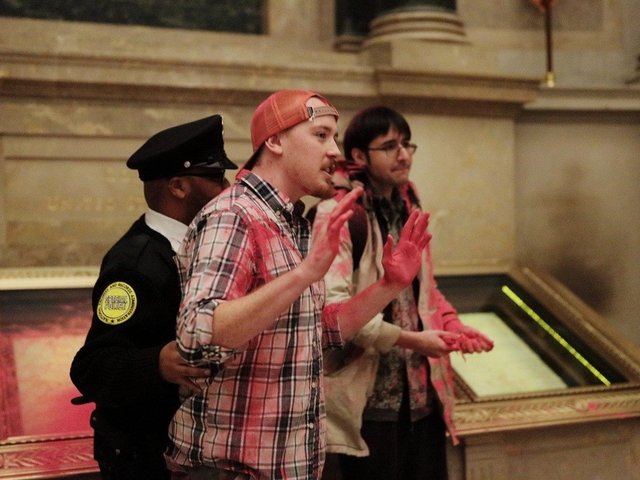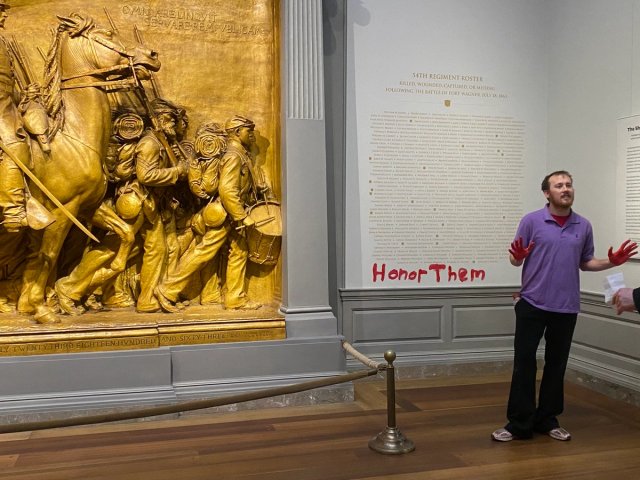Two members of the environmental activist group Declare Emergency have been charged with felony destruction of government property over a 14 February action in which they poured red powder on the display case at the US National Archives in Washington, DC, that contains the US Constitution. The Archives’ rotunda was closed for several days after the action for cleaning, which cost upwards of $50,000, according to the US Attorney's Office for the District of Columbia.
Both suspects in the action—Donald Zepeda of Maryland and Utah resident Jackson Green—were arrested after the incident. Zepeda was released on bond. Green, meanwhile, has been ordered held in jail in DC because, in carrying out the National Archives protest, he violated the terms of a previous release.
Earlier this year, Green was charged with damaging property of the National Gallery of Art for a November 2023 protest, during which he used red paint to write the words “Honor Them” on the wall next to Augustus Saint-Gaudens's Shaw 54th Regiment Memorial (1900), a monument to Black soldiers who fought in the US Civil War. After that incident, a judge had ordered Green to stay away from Washington, DC, and all public monuments and museums.
Green and Zepeda’s cases are ongoing, and are being investigated by several agencies including the Federal Bureau of Investigations’ Art Crime Team.
According to a statement by the National Archives, the US Constitution—the 1787 document establishing the laws of the new country—was not damaged in the attack. Analysis revealed the powder that coated the case and activists to be a mix of pigment and cornstarch. Dozens of conservators were involved in the process of cleaning the sophisticated display case that houses the four-page document.

Conservation staff members clean the case holding the US Constitution in the rotunda of the National Archives in Washington, DC, on 14 February National Archives photo by Ellis Brachman
“The cleaning of the Rotunda and preparation to reopen it was a large, collaborative effort involving [conservators], facilities personnel and building services contractors,” Stephanie Hornbeck, a National Preservation Program Officer, said in a statement. “Approximately 30 people were directly involved, contributing an estimated total of 335 person-hours.”
Referring to the pages of the Constitution, Hornbeck added: “They are well protected by the enclosure in separate anoxic encasements located inside of the well-sealed, robust exhibit cases.”
A previous action by Declare Emergency targeted Edgar Degas’s 1880 sculpture La petite danseuse de quatorze ans at the National Gallery of Art. The group’s actions in Washington, DC, are the most high-profile US examples to date of “eco-vandalism”, or climate activism targeting works of art. In the past two years, high-profile actions by climate advocacy groups like Just Stop Oil have focused on famous works at some of Europe's most popular museums, including the soup-splattering of Vincent van Gogh’s Sunflowers at London’s National Gallery and Leonardo da Vinci's Mona Lisa at the Louvre. These actions have attracted enormous media attention and prompted larger questions about the efficacy of these strategies in conveying the urgency of the current environmental moment.
An adjacent display case at the National Archives that holds the US Declaration of Independence was a major plot point in the Nicolas Cage blockbuster film National Treasure (2004), though presumably the systems that his character, named Benjamin Franklin Gates, was ultimately able to circumvent are not based on the National Archives’ actual security apparatus.





